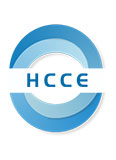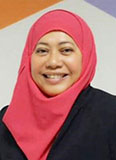

Keynote Speakers

Assoc. Prof. Rohayu Che Omar
Institute of Energy Infrastructure (IEI), Universiti Tenaga Nasional, Malaysia
Dr. Rohayu Che Omar is an Associate Professor of Geology Engineering at the College of Engineering, Universiti Tenaga Nasional (UNITEN), Kuala Lumpur. Her primary area of expertise is in engineering geology, slope risk management, and green material for slope stabilization toward sustainable environmental development.
Her career as a model researcher begins with the award of Gold and Best Environmental Award for Innovative Transmission Route Finder (ITRF) at the International Invention & Innovation Exhibition (ITEX) 2010 and INPEX USA 2012; Gold and Special Award for Innovative Monitoring Rating System (IMRS) from Taiwan Industrial Commercialization at Malaysia Technology Expo (MTE 2010); Gold and Best Award for Innovation in Vege-grout (VG2S) at KIWIE 2013, ITEX 2014, INPEX USA 2015, PENCIPTA 2016 and GENEVA 2021. She was awarded as Best Academic & Research Excellence Leadership Award in 2006 and 2016. She received the Leadership Innovation Fellowship Newton Award (LIF 2017) from the UK Royal Academic Engineering. She received amount of national and international research grants from 2016 to 2022, about RM 45 million. She has been granted three patents from ten filed patents through this project.
Speech Title: Disaster Resilience Index and Indicators System for Managing Risks in Hazardous Terrain (DRIMS)
Abstract: The methods for landslide mapping and landslide hazard assessment have experienced significant improvements during the last decade. The framework is integrated into one system to perform a landslide hazard assessment and mapping. However, the requirements of the users have become more challenging. Improving landslide protection techniques to stabilize a landslide may be too costly in financial or environmental terms. The abandonment of landslide-threatened areas can no longer be considered the only risk management alternative. Many local communities have progressively adopted the principles of living with risk and no longer accept the exclusion of landslide areas from development. This new context can only be managed with a better knowledge of the landslide mechanisms and their behavior. The existing procedures for landslide hazard assessment must be refined, and the potential risk must be quantified. At the same time, different technical solutions, especially in the domain of risk mitigation, must be searched to guarantee the appropriate level of safety for the infrastructure and population. Traditionally, the solutions have been focused on the implementation of mitigation measures in order to avoid slope failure, divert the moving mass away from vulnerable elements, and protect or reinforce the threatening elements. When mitigation is not feasible, it is essential to consider implementing indicator systems that may, at least, avoid damage and loss of infrastructure and human lives. The indicator also helps to make and prioritize the limited financial resources available to address these identified landslide remediation and prevention needs that can be executed objectively. However, it needs to ensure that the community and site mitigation through landslide prevention and mitigation will give stakeholders a reasonable rate of return (financial performance). It means that the modification of the current system is needed to ensure the portfolio modeling of proposed risk reduction will provide elements for an appropriate cost-benefit analysis of proposed solutions for enhancing disaster resilience in the built environment and humans.

Assoc. Prof. Jiwei Zhang
University of Science and Technology Beijing, China
Jiwei Zhang, Associate Professor, School of Civil and Resource Engineering, University of Science and Technology Beijing, Honorary Visiting Researcher at University of SUSSEX. He has vast practical experience in frozen rock and soil investigations, and laboratory and field testing to evaluate freezing state of frozen rock and soil for artificial freezing engineering. He has worked on more than 20 projects in special underground engineering construction field. He has published more than 50 research papers, 13 Chinese patents and won more than 5 prizes at the provincial level. He is member of Chinese Society for Rock Mechanics and Engineering (CSRME) and China Coal Society (CCS).
Speech Title: Evaluation of freezing state of sandstone using ultrasonic time-frequency characteristics
Abstract: Common problems in engineering projects that involve artificial ground freezing of soil or rock include inadequate thickness, strength and continuity of artificial frozen walls. It is difficult to evaluate the freezing state using only a few thermometer holes at fixed positions or with other existing approaches. Here we report a novel experimental design that investigates changes in ultrasonic properties (received waveform, wave velocity Vp, wave amplitude, frequency spectrum, centroid frequency fc, kurtosis of the frequency spectrum KFS, and quality factor Q) measured during upward freezing, compared with those during uniform freezing, in order to determine the freezing state in 150 mm cubic blocks of Ardingly sandstone. Water content, porosity and density were estimated during upward freezing to ascertain water migration and changes of porosity and density at different stages. The period of receiving the wave increased substantially and coda waves changed from loose to compact during both upward and uniform freezing. The trend of increasing Vp can be divided into three stages during uniform freezing. During upward freezing, Vp increased more or less uniformly. The frequency spectrum could be used as a convenient and rapid method to identify different freezing states of sandstone (unfrozen, upward frozen, and uniformly frozen). The continuous changes in reflection coefficient r4, refraction coefficient t4 and acoustic impedance field are the major reason for larger reflection and refraction during upward freezing compared with uniform freezing. Wave velocity Vp, wave amplitude Ah, centroid frequency fc and quality factor Q were adopted as ultrasonic parameters to evaluate quantitatively the temperature T of uniformly frozen sandstone, and their application within a radar chart is recommended. Determination of Vp provides a convenient method to evaluate the freezing state and calculate the cryofront height and frozen section thickness of upward frozen sandstone, with accuracies of 73.37%-99.23%.
